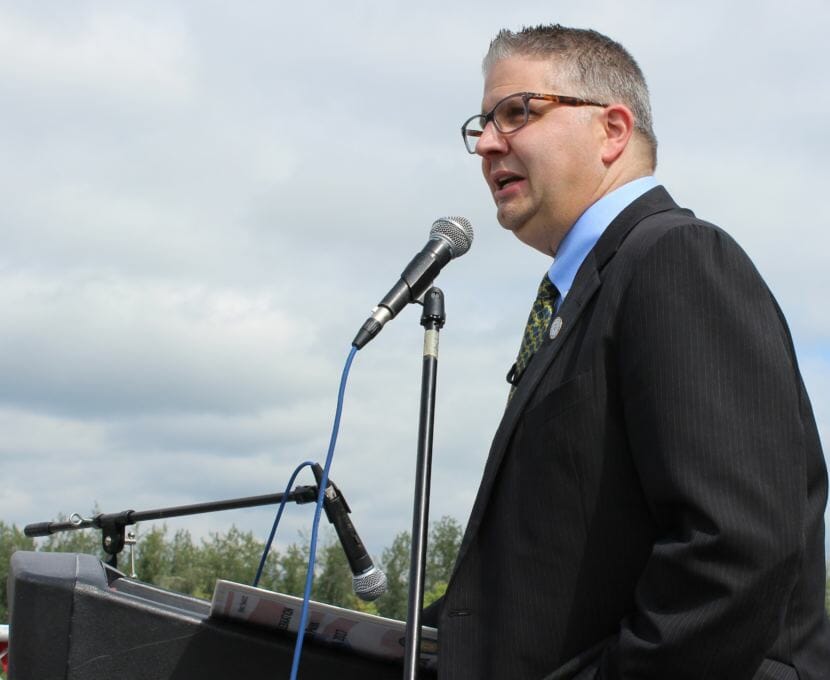
The city of Fairbanks has retained two Lower 48 law firms to advise on how to sue the manufacturers of chemical compounds that have contaminated groundwater in several areas around the city. The officials hope to recover nearly $4 million the city has spent over the past three years to deal with the contamination caused by perfluorinated compounds contained in a type of firefighting foam.
Mayor Jim Matherly said city officials hired the two law firms to help them develop a strategy on how the city can build a case that the companies found liable for the contamination should compensate the city for the cost of dealing with it.
“They’re going to take a look at our case, take a look at the foam issue, and the contamination issue,” he said. “They’ll talk to us, talk to our legal department.”
Matherly said City Attorney Paul Ewers recommended hiring San Francisco-based SL Environmental Law Group and New York-based Kennedy & Madonna because they’re experienced in litigating contamination cases. A city spokesperson said the two firms took the case on a contingency-fee basis, so they’d only get paid if they win the case and recover damages.
The mayor said the lawsuit would target the 3M Company, the Minnesota-based firm that manufactures the compounds known by the acronym PFAS. It’s used in the fire-suppressing foam that firefighters have for years used in training, among other things.
“The city was using that foam for about 20 years, between 1985 and around 2005,” he said. “Now what we use is we use a combination of some water, of course, for training and then we have another foam that we use that has been approved by the DEC.”
The move toward suing the manufacturer is good news, said Dave Berrey. He lives in one of the neighborhoods where the city has found PFAS groundwater contamination. But he and others say they wonder, what took the city so long to act?
“This is something we asked that they join in a year and a half ago, I believe,” he said, “and they turned a cold should toward us.”
Berrey said he and other affected residents think the city hasn’t focused enough attention on the problem and hasn’t adequately helped them, especially those suffering from health problems they believe are caused by the contamination. And he said they’d like to be more involved with the city’s efforts to recover damages from the manufacturer.
“They really need to look at who they’ve damaged in this negligence, and work with us to go after the chemical companies,” Berrey said.
The nearly $4 million the city’s paid so far was used to clean up sites and to cover the costs of connecting 44 properties in areas that rely on wells to the local water utility system. It’s also paid $2,500 stipends to those property owners to help offset their water payments.
Matherly said he’s not sure but he thinks Fairbanks is the first city in Alaska to pursue litigation in response to PFAS groundwater contamination. It’s turned up here more than any other city in the state, at least so far. And the mayor said the city’s asking the state for more help.
“I talked to the attorney general about this,” he said. “I told Gov. Walker about this. It’s in our legislative priorities to give to the Interior delegation, that we want the state to take a good hard look at this statewide. Because, we’re not the only city using this – it’s all across the nation.”
A recent study by the Environmental Working Group and the Social Science Environmental Health Research Institute at Northeastern University says PFAS pollution has been reported at 94 sites in 22 states. The study says PFAS has shown up in the tap water of some 16 million people in 33 states and Puerto Rico. Other estimates say up to 110 million Americans may have it in their drinking water.
The chemicals have been linked to kidney and testicular cancers, low birth weight, thyroid disease and pregnancy-induced hypertension.
The Alaska Department of Environmental Conservation has extended the public comment period on a proposed, more stringent cleanup level for groundwater contaminated with PFAS. Comments may now be submitted to DEC through 5 p.m. Tuesday, Nov. 12. More information on the proposed regs is available on this page of the DEC’s website.
